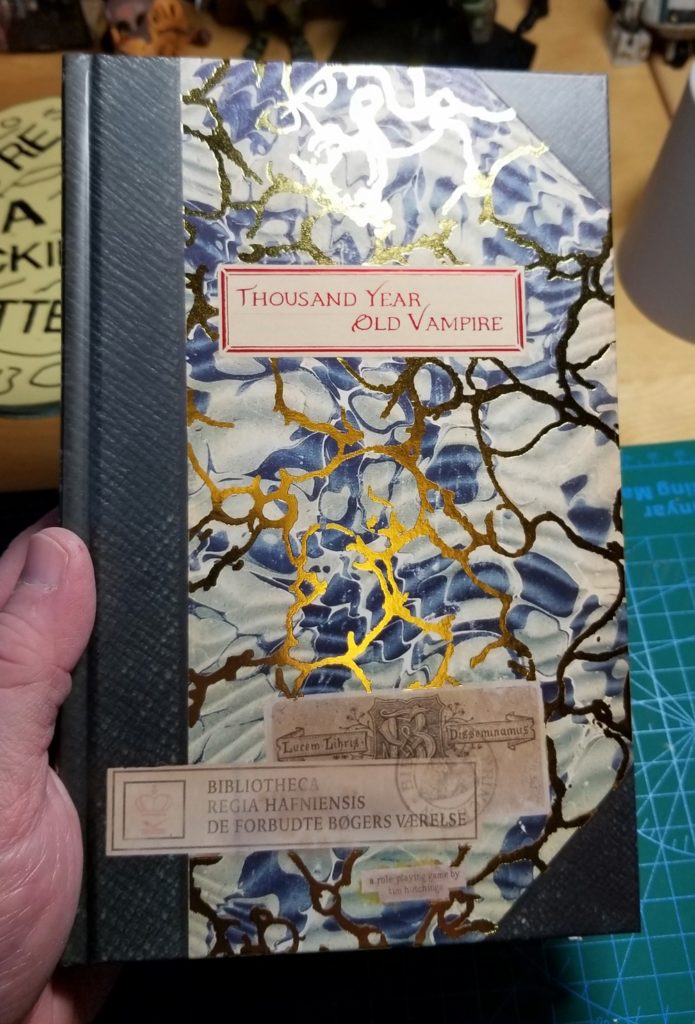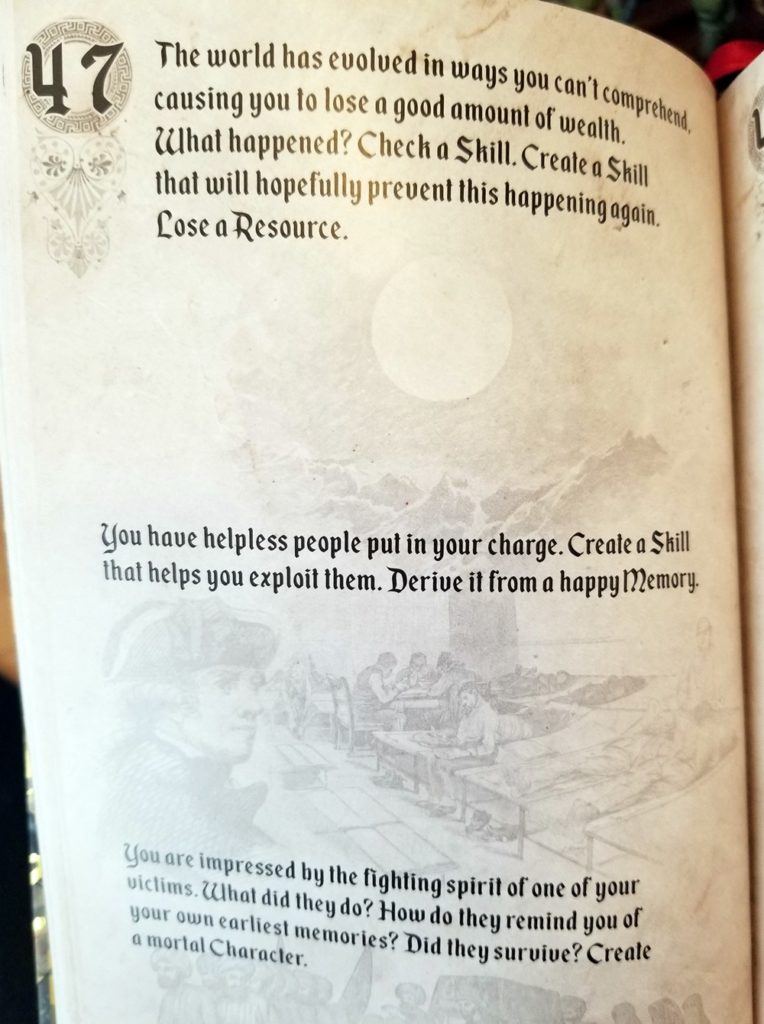I was going to do a Twitter thread while playing through Thousand Year Old Vampire (TYOV), a solo RPG by Tim Hutchings in which you’re an awful, awful vampire, but couldn’t figure out how to provide a meaningful content warning that would 1) persist and 2) allow people to avoid the whole thread while 3) still making it comprehensible. So here we are!
Content warning: violence, allusions to self-harm, gore, torture. Intended for a mature audience.
Also, this game is stunningly gorgeous and I highly recommend it. I posted about its beauty here on Yore; you can buy a copy from Tim on itch.io.

In this post I’m going to try to preserve the rapid-fire delivery of a Twitter thread because it suits the Quick Game for TYOV (one of its two modes of play) and my own inclinations.
Character creation
Your vampire is a collection of Memories, Experiences, Resources, Skills, other Characters, and the trait which identifies you as a vampire, your Mark. My first Experience is a character summary:
- I am Garnier, son of Roland and Isabeau, born in southern Brittany in 14th Century France; I became a monk to avoid poverty but found strength in my faith
It’s around 1340 at the start of this playthrough; the Black Plague is just starting its grim march through Europe.
I also came up with three Skills, three Resources, and Characters — and four more Experiences, each tied to those people/things. Here are my starting Characters:
- Melisende, a beautiful young woman in the village of Réconfort near the abbey; she visits regularly to transport wine made by the monks (mortal)
- Brother Eudes, a beautiful young monk who is secretly my lover; he loathes himself for straying from God (mortal)
- Abbot Roul, iron-fisted ruler of our abbey; he believes in harsh punishment for all offenses, no matter how minor (mortal)
- Qadir, an ancient, withered, stick-like vampire who haunts the abbey’s library, feeding on the monks; it illuminates manuscripts in blood (immortal)
Resources are a secret copy of the key to the abbey’s forbidden book room, a love letter from Brother Eudes, and my personal Bible I am illuminating for the abbey’s collection. Skills are Conceal My True Feelings, True Prayer, Skulking About. My other four Experiences are:
- Brother Eudes, at great personal risk, slips me a love letter during Mass; I feel truly alive for the first time
- I press the abbot’s key to the forbidden book room into a bar of wax and carve a copy; my visits there are frequent
- Melisende, to whom I am drawn, asks to see my illuminated Bible; I feel more strongly about my faith in God than I do about her
- I sneak into the abbey’s forbidden book room for the first time and encounter Qadir, its eyes coal-black; it mocks my prayers and delicately slits each of my wrists
And finally, my Mark — Garnier’s “vampire tell”: The wounds in my wrists never heal, and must always be bound or blotted with cloth; I cover them with my sleeves and change the dressings often.
This is a game about surprising yourself, and forgetting
As you move through the game’s prompts (with die rolls determining where you land), each will fuel a new bit of your story and require you to create an Experience. Some will prompt you to check off a Skill or Resource; the game ends when you must do that and cannot.
You’re not in complete control of your character. You make many of their decisions, but not all of them; it’s intended to make you uncomfortable, and it works.
When you gain enough Experiences, you’re forced to discard your Memories — flitting through the centuries, you cease to be who you were. Although, cruelly, you may retain legacies of those memories: people you used to know, skills you still possess despite having forgotten how you gained them, etc.
I’m not going to write out a whole journal here, nor give away Tim’s farm — rather, I’ll try to give you a sense for how the game plays and feels by sharing what came of the prompts I encountered on Garnier’s journey.
Prompt me, baby
The first prompt is always the same supposed to be rolled, but I picked prompt #1: you kill a mortal Character close to you, and gain the Bloodthirsty skill. (Updated because Tim mentioned on Twitter that the first prompt is the result of a die roll, like all the others.)
I kill Melisende the next time she comes to the abbey to collect the wine, drinking the blood from her wrists the way Qadir taught me; I feel nothing
Garnier
From there, die rolls lead you forward or back through the prompts — and each prompt is layered, so if you land on it again you can pick a new layer to explore.

My second was about being exposed:
I am found out to be a killer, and convince Eudes to run away with me, lying to him about everything; we pose as itinerant monks — I am now Roland
Garnier, now called Roland
I put that one under my Memory about my beloved Eudes. Unfortunately, he got the next prompt as well:
Unable to live with our many sins, my beloved Eudes threatens to reveal me; I kill him, and drink because I hunger
Roland (Garnier)
At this point I have 2/4 Skills checked and 0/3 Resources checked. These are still Garnier’s salad days.
Decades later, Garnier has forgotten all about the abbey’s forbidden book room (although not about Qadir) and the Plague has largely ended. He blends in for many years. Until:
I sneak into a monastery and drain every last monk; I leave the last one alive for days, draining him and watching, and then steal all their gold
Garnier
A couple observations
In solo games I tend to create the biggest piece of shit I can think of and then see what it’s like to live their life. I want to be uncomfortable, yet also delighted — in a slasher movie sort of way — at my character’s awfulness. TYOV is very much my jam.
TYOV is also an evil game. It fucks with you. It fucks with itself. It fucks with its own rules. It places you in discomfiting situations and makes you proceed.
For example: A century or more has passed and Garnier is now on his fourth name. He has fled to a foreign land, a place where he knows no one and doesn’t speak the language. I have to write an Experience for that . . . but if I fill up my first Memory, the one which appears first in this post, that will put me perilously close to forgetting who I am.
I don’t want to fill that slot.
Which, of course, is exactly the kind of gleefully wicked friction TYOV is designed to create.
Checking in with Garnier
A couple of centuries have passed. Garnier now lives in Greece. He has renounced God, discarding his 200-year-old personally illuminated Bible — which I chose to destroy over the letter from Brother Eudes.
One: holy shit, that’s making me feel things.
Two: how did Garnier preserve any faith for 200 years of being as evil as he is?
By the 17th Century, I no longer remember being Garnier at all. I strive to live an unremarkable mortal existence to avoid detection. In addition to my suppurating wrist wounds, I walk in an animal crouch and see Melisende — my first victim, who I no longer recall — in half the people I meet. I have been ground down by what feels like the inevitability of time, the curse of immortality weighing on me.
I’ve been happy precisely twice in 400 years: When Brother Eudes (who I later killed) confessed his love, and when I slipped into a 200-year torpor and felt nothing.
As fate and chance would have it, my last remaining skill is True Prayer. I’ve met my progenitor, the impossibly ancient vampire Qadir, and found in him now a kindred spirit. Little more than Qadir’s protection (which I’ve taken as a Resource) stands between me and the final death.
TYOV’s mechanics are deceptively simple. The natural probability of the roll you make every turn tends to drive you deeper into the book (though you do backtrack as well, just less often). The deeper you go, the more the prompts trend towards an ending — or an Ending, if you prefer.
I hit my final prompt and said aloud, “Holy shit, this is it.” And I knew instantly just what shitty, terrible form this ending would take for Theodorus — the name Garnier adopted in the 1600s and will now keep, eternally in the thrall of Qadir, the vampire who made him what he is.
My final Experience was this:
I am Qadir’s thrall, only his protection, his care, can stave off the final death; I live only to live, feeling nothing save the desire to continue being, forever
Theodorus
Fuuuuuuuuuuck that’s bleak.
Friends, Thousand Year Old Vampire is extraordinary. I’ve played a ton of solo RPGs, and this one does things I’ve never seen before. It lays out its goals and accomplishes all of them; it’s rewarding and moving and disturbing to play; and at the end of my first playthrough I feel wrung out.
This game rocks.

Sounds very cool. Now has someone written the Spaceman Spiff version for me? ;^)
For lighthearted CYOA-style solo play, I love the Chooseomatic Books series.
For non-grimdark SF with more meat on its bones than pure CYOA — IE much closer to TYOV — I recommend Rings of Ice. Wicked hard, lots of fun.
I will take a look! Thanks!
One question, one comment:
Is the “Decades Later” monastery a different monastery or the same monastery and he has forgotten that much that fast?
This strikes me as an interesting way to build elder characters for very dark vampire rpgs. Like the old 90s vtm. You just stop at whatever age you want them to be at the time/age of your game and hope they haven’t been destroyed by then.
No wait. Two questions. How big is this book? / How much play would you expect to get out of it before the results got samey?
Different monastery. Garnier learned to be a vampire from a creature who fed on monks; when he needed to kill, he went somewhere that felt familiar.
It being the same monastery would have been cool too, though! The rest of the story would have been colored by that choice.
TYOV does a LOT to keep itself replayable. There are 80 entries, and the first 71 each have three prompts. Die rolls ensure that your path will be variable, though always broadly arcing toward a conclusion; combine that with picking new prompts from the three-layered entries and you get a ton of variability.
There are also an additional 132 prompts in an appendix, themed around topics like “art” and “doom,” and those can be freely intermixed with the regular prompts. Many of those (most?) are also three layers deep.
And on top of all that, all of your starting character choices seem like they’d make even a 100% identical playthrough (which is statistically impossible) feel quite different the second time. Imagine Garnier were a Venetian boatman in the 1600s at the start, with a cast of Italian NPCs, and a vampire made of living shadow. Even if I chose to follow the exact same course through the book, I bet it would be a ton of fun and distinct from my Garnier playthrough.
How do you generate skills?
You just make them up. The book’s examples are Swordplay, Relaxing Banter, Operate Heavy Machinery, I Do Not Blink The Sand Away, and I Teach the Nanissáanah.